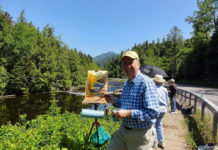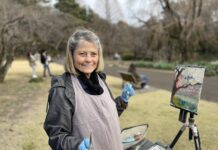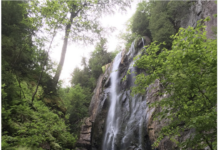
Paintings of the Golden State will be featured in two museum shows until next summer. All of our favorite painters and some new discoveries will be showcased.

“Plaza on Sunday,” by Phil Dike, 1942, oil on canvas. Mark and Jan Hilbert Collection. Included in the PMCA exhibition.
The Santa Barbara Museum of Art (SBMA) and the Pasadena Museum of California Art (PMCA) proudly present distinct selections of work that focus on the magnificent vistas and scenes of everyday life in the Golden State. Works in the two exhibitions tell a progressive story that starts with California Plein-Air Painting, or California Impressionism, in the early 20th century, and culminates with the California Regionalist art movement of the 1930s-1960s. Both exhibitions simultaneously display the “left coast” as a study of scenery, culture, and history, and illustrate what, ultimately, drove masses to its borders.
California Dreaming: Plein-Air Painting From San Francisco to San Diego will be on view at the Santa Barbara Museum of Art until June 16, 2013, while California Scene Paintings From 1930-1960 will be shown at the Pasadena Museum of California Art until July 28, 2013.

“Coast Line, Laguna,” by Clarence Hinkle, n.d. (ca. 1924), oil on canvas. Santa Barbara Museum of Art, Gift of Mabel Bain Hinkle. Included in the SBMA exhibition.

“California State Building, San Diego Exposition,” by Colin Campbell Cooper, 1916, oil on canvas. Santa Barbara Museum of Art, Gift of the Family of the Artist.
At the end of the 19th century, landscape painting had become the primary vehicle for depicting national identity in American art. California provided breathtaking scenery of newly integrated lands for painters working “en plein air,” or outdoors. As demonstrated by the paintings on view at the SBMA, this was an approach employed by cutting-edge artists in Europe, particularly in France, which artists in America then adapted to create a style that has become the hallmark of what is commonly termed California Plein-Air Painting or California Impressionism.

“Rain After Frost,” by Rex Brandt, 1937, oil on canvas. The Irvine Museum. Included in the PMCA exhibition.
In Northern California, an atmospheric, poetic, and decorative style called Tonalism was established by the artistic community of San Francisco. Southern California was a mecca for young, modernist artists influenced by French Impressionism, a movement preoccupied with capturing the immediate effects of light and color under ever-changing climactic conditions.
The story continues with PMCA’s presentation of nearly 75 artworks representing the larger Regionalist art movement of the 1930s through the 1960s. California Scene Painting — a term first used by Los Angeles Times art critic Arthur Millier — describes the representational art that captured scenes of everyday life in California.
California Scene Paintings From 1930 to 1960 at the PMCA features oil paintings, watercolors, drawings, and prints created in the decades when this was California’s most celebrated type of art. Some of the works in this exhibition were included in 1930s and 1940s exhibitions of Regionalist, American Scene, and WPA art in major museums across America. Key artists featured in the exhibition include Phil Dike, Emil Kosa Jr., Phil Paradise, Millard Sheets, Paul Sample, Ben Messick, Rex Brandt, and Dong Kingman. For more information, visit www.sbma.net or www.pmcaonline.org.




